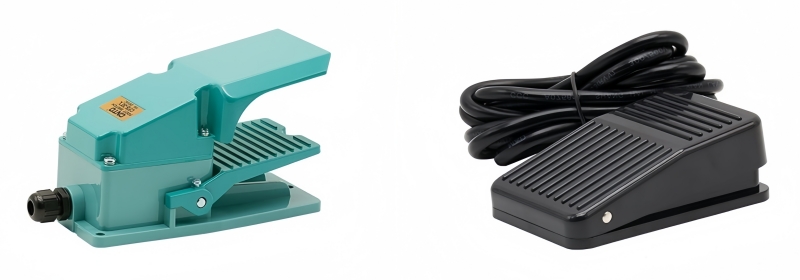How to Maintain Foot Switch?
The foot switch is a commonly used electrical control component. It controls the on and off of the circuit by the human foot. It is often used in control circuits that cannot be touched by both hands to replace the hands to achieve the purpose of the operation. Therefore, it is widely used in various fields such as mechanical equipment, production lines, and medical instruments to improve the degree of automation of production.

Advantages of Foot Switch
On one hand, the foot switch controls the on and off of the circuit by stepping on the foot. It is particularly suitable for use when the hands cannot move freely. This operation method can reduce the burden on the hands and improve work efficiency. Besides, it can avoid direct contact with the power switch by hand, thereby reducing the risk of electric shock. In some special environments, such as the chemical industry, laboratory, etc., it can effectively prevent accidental electric shock and ensure the safety of users, thereby reducing the risk of operating errors or accidental start-up of the machine.
On the other hand, foot switches usually have high wear resistance, impact resistance, and high temperature resistance, and are suitable for harsh working environments. Their surfaces are usually sprayed to enhance the protective layer and extend the service life. The design of cabled foot switches usually takes into account various environmental factors that may be encountered in actual use, such as moisture, grease, and impact. Their cable lead-out parts are usually equipped with cable heads to enhance the waterproof, oil-proof, and impact-proof effects. Therefore, they are not only suitable for the industrial field but also can be used in home automation systems, such as smart home control, to provide a more intelligent and convenient life experience.
Common Faults
If the problem is complicated, it is recommended to be repaired or replaced by a professional technician. At the same time, according to the actual application of the equipment, regular maintenance and inspection of the foot switch can effectively reduce the probability of failure and ensure production safety and efficiency. In daily production, ATO industrial automation recommends that you cut off the power supply first to ensure safe operation when dealing with the failure of the foot switch.
- The foot switch cannot open or close the device normally. First, check whether there are foreign objects blocking the switch. If the problem persists after removing the debris, it may be that the internal parts are damaged and a new foot switch needs to be replaced.
- The springs and copper sheets of the foot switch are prone to aging. After long-term use, problems such as insufficient spring force and charred contact surface will occur. During use, it will feel loose and unstable. Check whether the switch base is loose and fix it with tools if necessary. If the problem still exists, it may be that the internal parts are loose and the switch needs to be disassembled for repair or replacement.
- It takes force to start the device. This may be caused by the invasion of debris in the switch base or the aging of the spring. Cleaning the base or replacing the spring can solve the problem.
- The device flashes frequently or cannot work properly. Check whether the connection between the switch and the device is firm. If there is a connection problem, re-fix the connection. If the switch contact piece is oxidized, you can use fine sandpaper to gently wipe it to restore the conductivity.
- Heating or burning smell during use. First, check whether it is overloaded. Stop using it and replace the switch with a suitable power in time. If the problem persists, it may be that the internal circuit is short-circuited or damaged, and a new foot switch needs to be replaced.
Maintenance Tips
The maintenance of the foot switch is an important daily task that requires careful inspection, correct diagnosis, timely replacement of parts, and necessary cleaning and maintenance. By following the correct maintenance steps and precautions, the service life of the foot switch can be effectively extended to ensure the normal operation and safe use of the equipment.
Cleaning
Use a clean cloth or brush to remove dust and debris from the switch. If there are stubborn stains, wipe with a weak alkaline detergent and clean water, and then dry thoroughly. When cleaning, be careful not to damage the parts and keep them in their original state.
Lubrication
For parts that need lubrication, such as the rotating shaft of the foot pedal, add an appropriate amount of lubricating oil or grease to reduce wear and noise.
Functional Test
Perform functional tests on the foot switch regularly to ensure that it can respond to the foot pedal normally and switch quickly and reliably.
Replace Worn Parts
If some parts of the foot switch are found to be severely worn, such as the foot pedal, connecting wire, etc., they should be replaced in time to avoid malfunctions caused by wear.
Dust and Moisture Protection
When the foot switch is not used for a long time, it should be stored in a dry and ventilated place, and its status should be checked regularly. If necessary, a dust cover or moisture-proof facility should be installed. At the same time, during storage, be careful to avoid being affected by external forces to avoid damage.
Regular Inspection and Maintenance Records
Inspect the foot switch to ensure that its various parts, such as switch contacts, springs, and housings, are working properly without wear, looseness, or corrosion. It is best to establish a record system for regular inspection and maintenance, record the inspection time, content, replaced parts, etc., to help detect potential problems in a timely manner.

